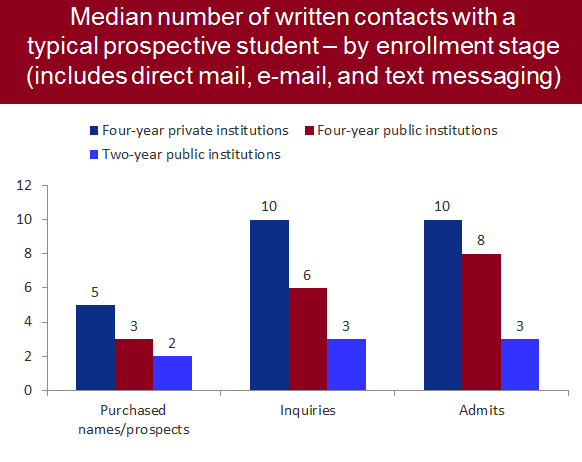enrollment
Sure, colleges send a lot of mail and e-mail to prospective students—but how much is it really?

This graph shows the median volume of written communications that colleges and universities send to a typical prospective student prior to enrollment by enrollment stage. The data are drawn from Noel-Levitz’s forthcoming report, 2011 Marketing and Student Recruitment Practices at Four-Year and Two-Year Institutions.
As the graph indicates, the frequency of written communication tends to increase as students move closer toward enrollment. For example, at the median, four-year public institutions typically make three written contacts with a student whose name they purchased from a list vendor, six written contacts with a student who inquires, and eight written contacts with an admitted student. As measured in this study, these figures represent the combined total of direct mail, e-mail, and text message contacts at each stage.
Also shown in the report, the volume of written contacts varies significantly between the median and the first and third quartile, showing that some colleges and universities send written communications much more frequently than others while others send much less. In addition, a significant portion of institutions—including more than half of four-year public and private institutions—indicated that they treat a subset of their purchased names like inquiries before students respond, which means this subset likely receives more contacts than do the other purchased names. (The latter trend has picked up steam in recent years; see our related white paper, In Pursuit of the Secret Shopper.)
Further, the report shows that two-year public colleges and four-year private institutions are more likely to use text messaging to communicate with prospective students than are four-year public universities, a finding which was consistent with the findings in our earlier report, 2010 E-Recruiting Practices and Trends at Four-Year and Two-Year Institutions. Specifically, the new report shows that text messaging is now used by 30 percent of four-year private institutions and by 26 percent of four-year public institutions, but only by 16 percent of four-year public institutions.
Watch for the new report to be released in June 2011 under “Papers and research” at www.noellevitz.com.